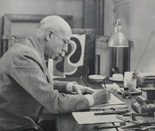
Léon Gischia was one of the most influential artists of the post-war Jeune École de Paris, an intellectual artist, who dedicated himself to painting in 1923 and enrolled at the Academie Moderne where he studied under Othon Friesz and Fernand Leger. In 1934 he worked with Leger, Mazenod and Le Corbusier on the Pavillon des Temps Nouveaux at the International Exposition in 1937. The following year he held his first one-man exhibition at the leading avant-garde gallery of Jeanne Bucher on Boulevard Montparnasse. In 1939 Galerie Alfred Poyet organised a further exhibition dedicated to Gischia’s work, launching him to the forefront of the Parisian artistic milieu. Over the next few years Gischia would play a major role in the development of the post-war avant-garde.
During the war, despite the Occupation, Gischia and a small group of fellow artists including Jean Bazaine, Alfred Manessier, Gustave Singier and Jean Le Moal managed to hold several highly important and controversial exhibitions in Paris, in protest of the Nazi’s neo-classical aestheticism and denigration of abstract art as “Degenerate”. The first, organised by Jean Bazaine and André Lejard at Galerie Braun in 1941, was Peintres de la Tradition Française. The second, Douze Peintres D’Aujourd’hui, was in 1943 at Galerie de France. Later in 1943 Gischia participated in a further exhibition at Galerie de France, Cinq Peintres d’Aujourd’hui, with Beaudin, Borès, Pignon, and Estève; and in 1944, Dix Peintres Subjectifs; and again in 1946, Six Peintres D’Aujourd’Hui. Of this group of young radical artists, Gischia was the dominant intellectual, and largely responsible for defining their new aesthetic of pure poetical expression that created a fluid dialectical exchange between man and nature, and would predominate the early post-war period in Paris.
Not favouring the established salons, Gischia became a founding-member of the radical Salon de Mai in 1946. This year he also held a significant one-man exhibition at Galerie Billiet-Caputo, and would hold further exhibitions there in 1947, and 1949. Further exhibitions in 1947 include Jeune Peintres de l’École de Paris in Zurich and Geneva. In 1948 he was selected to represent France at the Venice Biennale.
Gischia exhibited extensively both in France and abroad, and in recognition of his achievements he was awarded a comprehensive retrospective at the Musée du Havre in 1963. In the catalogue Frank Elgar writes, “Nous sommes en présence d’un créateur qui mortifie le lyrisme par crainte de l’éloquence... Gischia, lui, s’efforce courageusement d’inventer un language où espace, lumière et forme se trouvent éléves au même degré d’évidence dans l’expression à fois la plus riche et la plus châtiée”
Like many artists of the École de Paris, Gischia maintained a diverse and pluralist approach to art, painting murals and designing scenery and costumes for many productions, notably at the Theatre National Populaire, where he was appointed Jean Vilar’s official designer. He also wrote two books, Les Arts Primitif and La Sculpture en France depuis Rodin.
The artist is represented in numerous major museums of modern art, including: Musée National d’Art Moderne, Centre Georges Pompidou, Paris; Le Havre; Marseille; Amsterdam; Liege; Brussels; Turin; Victoria & Albert Museum, London; Art Museum of New Zealand; also throughout the USA; and has been give retrospectives at the Paris Art Centre, 1985; Galerie d’Art International Paris, 1988; Musée de Zagreb, 1988; Musée de Borda, 1988; Paris Art Centre, 1990; and participated in the Venice Biennale in 1988.